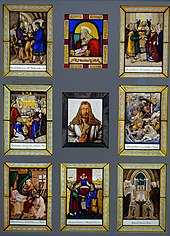Albrecht Dürer on his mother's deathbed
The transparent image of Ernst Förster named Albrecht Dürer at the deathbed of his mother is the fifth transparent a picture cycle of seven, set up under the Dürer festival to Nuremberg had been issued in the year. 1828 The original was destroyed during the bombing of Nuremberg, but there are authentic copies made by contemporary artists.
The banner
The original was created by Ernst Förster in 1828 on a banner almost 2 meters high. It shows Albrecht Dürer , who sits praying at the foot of the bed of his sick mother Barbara Dürer . Also present are Dürer's wife Agnes and a maid . As a basis for creating the picture, Förster used the episode from the 'Relics of Dürer' in which Dürer describes the illness and death of his mother.
The image references are striking in terms of their reference to the traditional iconography of the Virgin Mary . The composition can thus be compared with that of a dormition , the 'dormition' of Mary. This type of image can be traced back to the Middle Ages.
When depicting Dürer, Förster refers to his self-portrayal in the self-portrait from 1500, in which Dürer stages himself analogously to depictions of Christ, which at that time were reserved for Christ himself and rulers. As in the entire cycle, hairstyle and clothing are particularly important indicators.
Consequently, Dürer's mother Barbara is portrayed like Mary , the Mother of God . Although it is not located in the circle of saints or apostles according to the type of picture, the implied context can be read from the constellation of the group of people. Further references to Mary are, on the one hand, the depiction of the Madonna on the easel in the right background and the rosary on the nightstand on the left in the foreground, the history of which is closely linked to the history of the veneration of Mary.
Based on the ideals of the group known as the Nazarenes , whose member Peter von Cornelius was one of the initiators of the Nuremberg Dürer Festival and also teacher of Ernst Förster, the references to motifs of Christian art and a special emphasis on artists of the Renaissance are understandable.
The copies
Johann Phillipp Walther and Franz Joseph Sauterfolk made copies of the cycle as early as 1829 .
The copper engravings by Walther are in the Nuremberg Collection of Graphics , the glass version by Sauterfolk is on loan from the city of Nuremberg in the Germanic National Museum in Nuremberg .
background
The Dürer Festival in Nuremberg in 1828 was one of many commemorations in Germany on the occasion of the 300th anniversary of Albrecht Dürer's death.
The event in Nuremberg was characterized by the lively participation of artists from all over Germany, who took part in various ceremonial acts in Nuremberg's old town between April 6 and 10, 1828.
This included:
- a visit to Dürer's grave in the Johannisfriedhof
- Parade past Dürer's houses
- Presentation of the transparent paintings in the old town hall
- Laying of the foundation stone for the memorial statue on Albrecht-Dürer-Platz
- Attending a play with the title 'Albrecht Dürer'
Individual evidence
- ↑ Hans Rupprich: Dürer's written estate and its publication . In: Anzeiger des Germanisches Nationalmuseum . Nuremberg 1954, p. 7-17 .
- ^ German biography: Walther, Johann Philipp - German biography. Retrieved January 28, 2020 .
- ^ Margot Blumenthal: The Dürer celebrations 1828. Art and society in the Vormärz. Verlag der Deutsche Hochschulschriften, Frankfurt am Main 2001, ISBN 978-3-8267-1191-6 , p. 278 .


